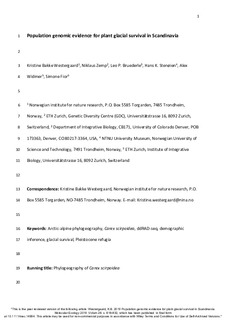Population genomic evidence for plant glacial survival in Scandinavia
Westergaard, Kristine Bakke; Zemp, Niklaus; Bruederle, Leo P.; Stenøien, Hans K.; Widmer, Alex; Fior, Simone
Journal article, Peer reviewed
Accepted version
Permanent lenke
http://hdl.handle.net/11250/2588875Utgivelsesdato
2019Metadata
Vis full innførselSamlinger
- Institutt for naturhistorie [1223]
- Publikasjoner fra CRIStin - NTNU [37994]
Sammendrag
Quaternary glaciations have played a major role in shaping the genetic diversity and distribution of plant species. Strong palaeoecological and genetic evidence supports a postglacial recolonization of most plant species to northern Europe from southern, eastern and even western glacial refugia. Although highly controversial, the existence of small in situ glacial refugia in northern Europe has recently gained molecular support. We used genomic analyses to examine the phylogeography of a species that is critical in this debate. Carex scirpoidea Michx subsp. scirpoidea is a dioecious, amphi‐ Atlantic arctic–alpine sedge that is widely distributed in North America, but absent from most of Eurasia, apart from three extremely disjunct populations in Norway, all well within the limits of the Weichselian ice sheet. Range‐wide population sampling and variation at 5,307 single nucleotide polymorphisms show that the three Norwegian populations comprise unique evolutionary lineages divergent from Greenland with high between‐population divergence. The Norwegian populations have low within‐population genetic diversity consistent with having experienced genetic bottlenecks in glacial refugia, and host private alleles that probably accumulated in long‐term isolated populations. Demographic analyses support a single, pre‐Weichselian colonization into Norway from East Greenland, and subsequent divergence of the three populations in separate refugia. Other refugial areas are identified in North‐east Greenland, Minnesota/Michigan, Colorado and Alaska. Admixed populations in British Columbia and West Greenland indicate postglacial contact. Taken together, evidence from this study strongly indicates in situ glacial survival in Scandinavia. arctic–alpine phylogeography, Carex scirpoidea, ddRAD‐seq, demographic inference, glacial survival, Pleistocene refugia
